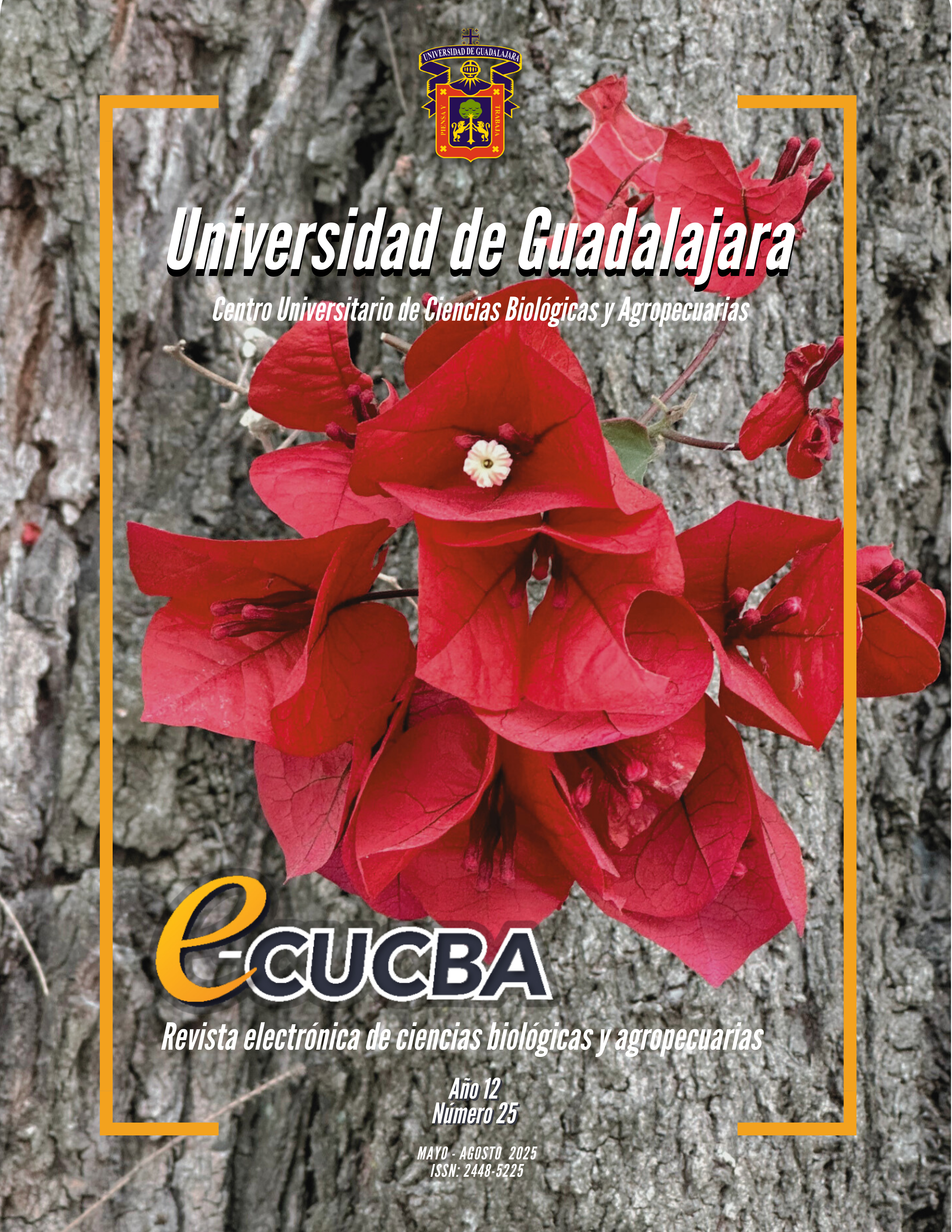Evaluación del perfil fenólico, contenido de fenoles y actividad antioxidante de Dichondra argentea
Evaluation of the phenolic profile, phenol content, and antioxidant activity of Dichondra argentea
DOI:
https://doi.org/10.32870/e-cucba.vi25.383Palabras clave:
Medicina tradicional, flavonoides, plantas, DurangoResumen
Dichondra argentea es una planta empleada en la medicina tradicional, donde se ha utilizado para aliviar dolores estomacales, regular la fiebre y tratar afecciones cardíacas, entre otros usos. Por ello, es fundamental respaldar su utilización con estudios científicos que validen su efectividad y seguridad en el ámbito medicinal. En el presente trabajo se determinó el contenido total de fenoles y flavonoides mediante análisis espectrométricos, la actividad antioxidante se evaluó midiendo la capacidad bloqueadora de los radicales libres 2,2-difenil-1-picrilhidrazil (DPPH*) y ácido 2,2’-azino-bis (3-etilbenzotiazolina-6-sulfónico (ABTS*+). Los resultados revelaron un contenido total de fenoles de 115.27±0.86 mg EAG/g ES y un contenido total de flavonoides de 31.56 ± 1.97 mg EQ/g ES. En cuanto a la actividad antioxidante los extractos etanólicos de Dichondra argentea registraron un valor de EC50DPPH de 1.60 ± 0.005 mg/mL y un valor de EC50ABTS de 0.68 ± 0.004 mg/mL. Dado que Dichondra argentea ha sido poco estudiada, este trabajo muestra información importante sobre esta planta.
Citas
Agbo, M. O., Uzor, P. F., Akazie Nneji, U. N., Eze Odurukwe, C. U., Ogbatue, U. B. y Mbaoji, E. C. (2015). Antioxidant, Total Phenolic and Flavonoid Content of Selected Nigerian Medicinal Plants. Dhaka University Journal of Pharmaceutical Sciences, 14(1), 35–41. https://doi.org/10.3329/dujps.v14i1.23733
Ávila-Reyes, J. A., Almaraz-Abarca, N., Chaidez-Ayala, A. I., Ramírez-Noya, D., Delgado-Alvarado, E. A., Torres-Ricario, R., Naranjo-Jiménez, N. y Alanís-Bañuelos, R. E. (2018). Foliar phenolic compounds of ten wild species of Verbenacea as antioxidants and specific chemomarkers. Brazilian Journal of Biology, 78(1), 98-107. https://doi.org/10.1590/1519-6984.07516
Barrera-Vázquez, O. S., Montenegro-Herrera, S. A., Martínez-Enríquez, M. E., Escobar-Ramírez, J. L. y Magos-Guerrero, G. A. (2023). Selection of Mexican Medicinal Plants by Identification of Potential Phytochemicals with Anti-Aging, Anti-Inflammatory, and Anti-Oxidant Properties through Network Analysis and Chemoinformatic Screening. Biomolecules, 13(11), 1673. https://doi.org/10.3390/biom13111673
Brand-Williams, W., Cuvelier, M. E. y Berset, C. (1995). Use of a free radical method to evaluate antioxidant activity. LWT-Food Science and Technology, 28, 25-30.
Campos, M. G. y Markham, K. R. (2007). Structure information from HPLC and on-line measured absorption spectra-flavone, flavonoids and phenolic acids. Coimbra University Press. Portugal.
Cobaleda-Velasco, M., Alanis-Bañuelos, R. E., Almaraz-Abarca, N., Rojas-López, M., González-Valdez, L. S., Ávila-Reyes, J. A. y Rodrigo, S.(2017). Phenolic profiles and antioxidant properties of Physalis angulata L. as quality indicators. Journal of Pharmacy & Pharmacognosy, 5(2),114-128https://www.redalyc.org/articulo.oa?id=496053942005
Cuevas-Cianca, S. I., González-Campos, R. E., Mejía Méndez, J. L., Sánchez Arreola, E., Juárez, Z. N. y Hernández, L. R. (2023). Anticancer Properties of Mexican Medicinal Plants: An Updated Review. Natural Product Communications, 18(7). https://doi.org/10.1177/1934578X231187458
Do, P. (2023). Oreja de ratón: Cómo cuidar de la planta Dichondra argentea. Planta.do. https://planta.do/blogs/pulgar-verde/oreja-de-raton-como-cuidar-de-la-planta%20dichondra-argentea
González, M., López, I. L., González, M. S. y Tena, J. A. (2004). Plantas medicinales del estado de Durango y zonas aledañas. pp. 113
Gutiérrez-Velázquez, M. V., Almaraz-Abarca, N., Herrera-Arrieta, Y., Ávila-Reyes, J. A., González-Valdez, L. S., Torres-Ricario, R., Natividad-Uribe, J. N. y Monreal García, H. M. (2018). Comparison of the phenolic contents and epigenetic and genetic variability of wild and cultivated watercress (Rorippa nasturtium var. aquaticum L.). Electronic Journal of Biotechnolog, 34, 9-16. https://doi:10.1016/j.ejbt.2018.04.005
Jongrungraungchok, S., Madaka, F., Wunnakup, T. Sudsai, T., Pongphaew, C., Songsak, T. y Pradubyat, N. (2023). In vitro antioxidant, anti-inflammatory, and anticancer activities of mixture Thai medicinal plants. BMC Complementary Medicine and Therapies, 23(43). https://doi.org/10.1186/s12906-023-03862-8
Martínez-Rocha, A., Puga, R., Hernández-Sandoval, L., Loarca-Piña, G. y Mendoza S. (2007). Antioxidant and antimutagenic activities of Mexican oregano (Lippia graveolens Kunth). Plant Foods for Human Nutrition, 63(1). https://doi.org/10.1007/s11130-007-0061-9
Ordoñez, A. A. L., Gomez, J. D., Vattuone, M. A. y Isla, M. I. (2006). Antioxidant activities of Sechium edule (Jacq.) Swartz extracts. Food Chemistry, 97, 452-458. https://doi.org/10.1016/j.foodchem.2005.05.024
Palma-Wong, M., Ascacio-Valdés, J. A., Ramírez-Guzmán, N., Aguirre-Joya, J. A., Flores-Loyola, E., Ramírez-Moreno, A. y Torres-León, C. (2023). Exploration of Phenolic Content and Antioxidant Potential from Plants Used in Traditional Medicine in Viesca, Mexico. Horticulturae, 9(12), 1252. https://doi.org/10.3390/horticulturae9121252
Pandey, L.K. y Sharma, K. R. (2022). Analysis of Phenolic and Flavonoid Content, α-Amylase Inhibitory and Free Radical Scavenging Activities of Some Medicinal Plants. The Scientific World Journal. https://doi.org/10.1155/2022/4000707
Pascual, C. D., Pérez, C. Y. E., Morales, G. I., Castellanos, C. I. y Gonzalez H. E. (2014). Some considerations on the emergence and history of natural and traditional medicine. MediSan, 18(10).
Re, R., Pellegrini, N., Proteggente, A., Pannala, A., Yang, M. y Rice-Evans, C. (1999). Antioxidant activity applying an improved ABTS radical cation decolorization assay. Free Radical Biology and Medicine, 26, 1231-1237. https://10.1016/s0891-5849(98)00315-3.
Rzedowski, G. C., Rzedowski, J. (2001). Flora fanerogámica del Valle de México. 2a ed. Instituto de Ecología y Comisión Nacional para el Conocimiento y Uso de la Biodiversidad. Pátzcuaro, Michoacán, México.
Silva, C. G., Herdeiro, R. S., Mathias, C. J., Panek, A. D., Silveira, C. S., Rodrigues, V. P., Rennó, M. N., Falcão, D. Q., Cerqueira, D. M., Minto, A. B., Nogueira F. L., Quaresma, C. H., Silva, J. F. y Menezes, F. S. (2005). Eleutherio EC. Evaluation of antioxidant activity of Brazilian plants. Pharmacol Research, 52(3), 229-33. https://10.1016/j.phrs.2005.03.008
Sheu, M., Deng, J., Huang, M., Liao, J., Wu, C., Huang, S. y Huang, G. (2012). Antioxidant and anti-inflammatory properties of Dichondra repens Forst. and its reference compounds. Food Chemistry, 132, 1010-1018. https://doi.org/10.1016/j.foodchem.2011.09.140
Skotti, E., Anastasaki, E., Kanellou, G., Polissiou, M. y Tarantilis, P. A. (2014). Total phenolic content, antioxidant activity and toxicity of aqueous extracts from selected Greek medicinal and aromatic plants. Industrial Crops and Products, 53, 46-54. https://doi.org/10.1016/j.indcrop.2013.12.013
Vivot, E. P., Sánchez, C., Cacik, F. y Sequin, Christian. (2012). Antibacterial activity of medicinal plants in the flora of Entre Ríos (Argentina). Ciencia, docencia y tecnología, (45), 131-146. https://www.scielo.org.ar/scielo.php?script=sci_arttext&pid=S1851-17162012000200008&lng=es&tlng=en
Descargas
Publicado
Cómo citar
Número
Sección
Licencia
Derechos de autor 2025 Marcela Verónica Gutiérrez-Velázquez, Rene Torres-Ricario, José Antonio Ávila-Reyes, Eli Amanda Delgado-Alvarado, Hugo Manuel Monreal-García, Shaila Nayeli Pérez-Salinas, Jose Enrique Herbert-Pucheta, Liliana Wallander-Compean, Aixa Najla Bujdud-León

Esta obra está bajo una licencia internacional Creative Commons Atribución-NoComercial-SinDerivadas 4.0.






